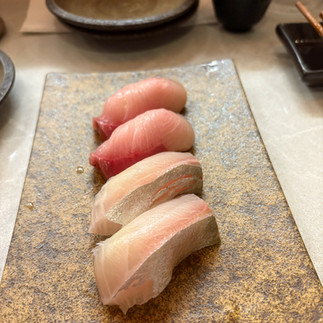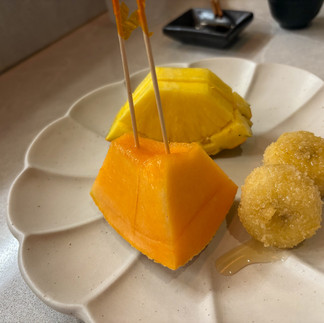I Leave It Up to You
- Sarah Rodriguez

- Aug 20
- 4 min read
Exton, PA
June 2025
My best friend, Cora, and I recently treated ourselves to Omakase at Bluefin Eagleview. We went into this new experience open and excited. I learned about Omakase through the book that I read, I Leave It Up to You by Jinwoo Chong. This novel is about a man who wakes up from a coma and returns to working in his estranged family’s sushi restaurant, finding family and love along the way. The book was great, and it inspired me to try Omakase.
Omakase is a Japanese dining style that translates from Japanese to English as I’ll leave it up to you or I trust you, chef. Omakase involves a multi-course meal where the chef selects and prepares dishes based on the diner’s preferences, often featuring sushi and seasonal ingredients. In the U.S., it is usually enjoyed at the sushi counter where the chef prepares one piece at a time and engages with the diner(s) about the dishes being served. This dining experience emphasizes trust in the chef’s expertise and creativity, allowing diners to enjoy a unique culinary journey.
I asked Cora to join me on this culinary journey because I knew that she enjoys raw fish and is open to trying different foods. We were TREATED during our Chef’s Omakase dining experience.
We started off with Oysters with a Ponzu Aji Ceviche Sauce which had a delightful balance of tangy, spicy, and umami flavors. I have never had an oyster before this experience and they were so good, the sauce was everything!
Next, we had Scallop Crudo, a delicious and elegant appetizer made with thinly sliced raw scallops and a simple dressing. I have no notes. Gordon Ramsay would have liked it.
Then we had a Honeycrisp Seafood Salad that made for a light and flavorful dish. We were in heaven.
Afterwards we had Thai Sunomono with Kanpachi, a delightful combination that marries the delicate richness of the Kanpachi with the bright vibrant flavors of the Thai-style cucumber salad. My mouth is watering just thinking about this meal.
That was followed by B3 Wharton, a piece of sushi containing tuna, salmon, kani (imitation crab), avocado, mango, and masago (fish roe). It is hard to pick favorites, but this was incredible.
We then had Maori, Kinmedai, and Ishidai. Kinmedai translates to golden eye snapper although it is a splendid alfonsino, a deep-sea fish. Ishidai translates to stone porgy or stone perch, but it is also known as striped beakfish, barred knifejaw, or striped knifejaw. Kinmedai is known for its delicate sweetness and richness while Ishidai offers a clean flavor and a unique texture.
Next, we had Akami, Chutoro, and Otoro which are three distinct cuts of tuna. Akami is the leanest, darkest red, and firmest cut. Chutoro is moderately fatty, offering a balance of flavors and textures. Otoro is the fattiest, known for its buttery, melt-in-your-mouth texture and rich flavor.
At this point, Cora and I were fighting to keep up as we were getting full. The fullness sneaks up on you since they are small plates but do not be deceived, it will get you. Luckily, Cora and I are not quitters, and we continued on because everything just tasted so good that we could not help but clear each plate.
We then had one piece that we liked, Sake Nigiri, and one that we did not, Sake Toro. Sake Nigiri features hand-pressed rice topped with slices of salmon. It has a soft texture and clean finish. Sake Toro is salmon belly and is considered the most prized part of the fish due to its rich omega-3 fat content and buttery texture. The Sake Toro was the first item of this culinary experience that I did not love.
This was followed by Hamachi and Shima-Aji. Hamachi is the younger version of the Japanese amberjack or yellowtail and has a mild but slightly sweet flavor with a firm, buttery texture. Shima-Aji is also known as striped jack and is characterized by its firm and luscious flesh with a balanced amount of fat. This fish is considered a luxury item and is relatively rare in the wild.
Afterwards we had Uni on Wagyu Beef in a bed of greens (lettuce and seaweed with rice). I was very excited to try uni as I have not had it before. Upon researching the various fish that we ate after the meal for this post I learned that uni is the only edible part of the sea urchin, and it is the reproductive organs of the creature. If I had known this beforehand, I am not sure if I would have been as daring to eat it but the creamy, oceanic flavor with a hint of sweetness did pair nicely with the melt-in-the-mouth texture of the wagyu.
Our last fish was Unagi Tamago, grilled eel paired with tamagoyaki. Tamagoyaki is a type of Japanese omelette made by rolling together several layers of fried beaten eggs. It is often prepared in a rectangular omelette pan called a makiyakinabe or tamagoyaki. The combination of the two has a smoky and sweet taste. This dish did not do it for me.
Our first of two dessert plates was fruit. We were given cantaloupe, pineapple, and a sweet, coated banana. I ate the cantaloupe, and Cora ate the pineapple and banana. This was a refreshing break.
Our last dessert and final overall dish was Sweet Potato Split. This was ice cream with sweet potatoes. It sounded like it would be bad, and we were hesitant, but it tasted amazing, truly delicious!
This was an epic culinary journey that encompassed my body, mind, and soul with every bite. I appreciate the art and craft that went into each plate. For all that we got, I think that the price of $127 per person was reasonable. In total with tip, I spent a little over $150 for an unforgettable night. I highly recommend this experience to those willing to step out of their comfort zone and give it a try! While not every dish was a hit for my taste, I am so grateful for the opportunity to try so many new things and appreciate another culture. I cannot wait until my next Omakase!


















































Comments